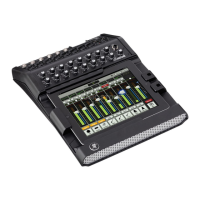Mackie DL806 and DL1608 Reference Guide
66
Vintage EQ Introduction
Many of our audio engineer friends and other pro audio gear heads yearn for the ease of use and sound
ofyesteryear.That’sright,thevintageEQwascreatedwithyouinmind...buteveryuserwillloveusingit!
It meticulously recreates the feel and sound of EQ of classic consoles. The vintage EQ captures the unique
interactions between the shelving bands and the gain and frequency-dependent Q structure of the
parametric band to deliver the clarity and sheen of classic EQ designs. The vintage EQ is great for shaping
the tone of bass, guitars and other instruments. The screen shot below displays the default vintage EQ
settings.Let’stakealookateachoftheselectionsstartingontheleftwiththeHPFandworkingourway
right to the high EQ.
Vintage EQ Swipe Zone
Here in the Vintage EQ view, swipe anywhere in the dark gray areas outlined below. Swiping up displays
thatchannel’sgateandcompressorview.Swipingdowndisplaysthatchannel’sFXview.Andswiping
left and right changes channels.
Vintage EQ HPF Frequency Buttons
High-pass lters are utilized to cut out low frequencies. The high-pass lter control adjusts the cut-o
frequency for the lter. Frequencies below the cut-o frequency are attenuated at a rate of 18 dB/octave.
TheslopeoftheHPFisengagedby
tappinganyfrequencybuttonotherthan“O”.Thecurrentselection
will illuminate green.
Vintage EQ Gain and Frequency
ThegainforeachEQbandmaybechangedbydraggingup[increasesgain]anddown[decreasesgain]
over the knob until the desired gain has been achieved. The gain may be changed by approximately
±15dB...it’svintage,sonothingisexact! Double-tap a gain knob to reset its gain to zero. Each EQ band
here has a vertical row of frequency buttons located underneath its gain knob. Simply tap the frequency
button you desire for each band. The frequency ranges from 35 Hz to 15 kHz. The gain (but not the
frequency) may also be manually entered via the current parameter display.
Low
The low EQ provides approximately 15 dB of boost or cut from 35 Hz to 330 Hz. This frequency
represents the punch in bass drums, bass guitar, fat synth patches, and some really serious male
singers who eat raw beef for breakfast.
Mid
The mid EQ provides approximately 15 dB of boost or cut from 360 Hz to 7.2 kHz. Frequencies aected
typically include guitar, piano and the fundamentals and harmonics of many instruments.
Wide / Narrow
Below the mid EQ vertical frequency strip is a wide / narrow button. Generally speaking, wide is
used for broad tone-shaping while narrow is more precise. Select what you would prefer the mid
frequencyQ[bandwidth]tosoundlike.
High
ThehighEQprovidesapproximately15dBofboostorcutfrom3.3kHzto15kHz.Useittoadd
sizzle to cymbals, an overall sense of transparency, or an edge to keyboards, vocals, guitar
and bacon frying. Select a lower frequency to reduce sibilance or harsh treble.
Vintage EQ at a Glance
Parameter Low Value Limit High Value Limit Default
PolarityInvert O On O
HPFEnable O On On
HPFFrequency O•50Hz•80Hz•160Hz•300Hz 80 Hz
HPFSlope O 300 Hz 18 dB/octave
EQ Enable O On On
High Shelf Gain –15 dB +15dB 0 dB
High Shelf Freq 3.3kHz•4.7kHz•6.8kHz•10kHz•15kHz 10 kHz
Mid Gain –15 dB +15dB 0 dB
Mid Freq 360Hz•700Hz•1.6kHz•3.2kHz•4.8kHz•7.2kHz 360 Hz
Mid Q Wide Narrow Narrow
Low Shelf Gain –15 dB +15dB 0 dB
Low Shelf Freq 35Hz•60Hz•110Hz•220Hz•330Hz 60 Hz

